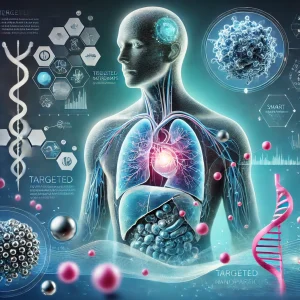
Research Programme 3 (RP3) focuses on the search for new cancer biomarkers that would facilitate early tumour detection, eventually early prevention of tumours. In 2024, some significant results were achieved, both in collaboration between research teams gathered in the NICR and thanks to the collaboration of NICR teams with other researchers. This led to the publication of almost 40 scientific articles, which contributed to a further refinement of cancer diagnostics and thus to a personification of therapy.
In accordance with project plans, NICR research focused on the study of colorectal cancers, pancreatic ductal carcinoma, malignant melanoma, squamous carcinoma of the skin and mucosa, breast and prostate carcinoma, and the study of haematological malignancies.
Focus on the malignant transformation of cancer cells
Researchers have studied changes associated with the malignant transformation of cancer cells, including driver mutations, deregulations of differentiation, proliferation and migration, and the mechanism of metastasis. A team from the Faculty of Medicine of Charles University in Pilsen had, in collaboration with colleagues from Heidelberg, discovered the typical expression pattern of non-coding RNA (mainly miRNAs and lncRNA) specific for hepatocellular carcinoma. Analysis of such non-coding RNAs in patients’ serum can thus be used for a non-invasive monitoring of disease progression, which could ultimately inform treatment decisions and influence patient survival.
HPV viruses are known inducers of cervical squamous cell carcinoma and carcinomas of the head and throat. Improvements in their detection in tissue samples that have been achieved by a team from the Masaryk Memorial Cancer Institute and Faculty of Science of the Masaryk University in Brno are thus crucially important for diagnosis and subsequent treatment of patients with these diseases.
Focus on precision oncology
Precision oncology plays an increasing role in the optimal setting of patients’ treatment. The bioinformatic instrument PredictONCO, newly developed by a team that includes researchers from the Faculty of Science and the Faculty of Medicine of the Masaryk University, Czech Technical University, St Anne’s University Hospital in Brno, CEITEC, and University Hospital Brno plays an important role in this effort. This system, equipped with an advanced computing algorithm, machine learning, and extensive use of AI, is capable of analysing the impact of genetic mutations on the progression of cancer. In conjunction with other clinical data, it can thus help select a suitable treatment approach for each individual patient. The PredictONCO was now incorporated into a precision oncology system actively used in the University Hospital Brno.
A Brno-based team from the Faculty of Medicine and CEITEC of the Masaryk University had published an article that documents the contribution of integrative genomic and transcriptomic analysis for the diagnostics and targeted treatment of paediatric cancer patients. This study, which included 248 patients, had demonstrated the potential of therapeutic use of molecular findings in almost half of the patients. Precision oncology methods enable a personalisation of treatment not only based on the tumour type but also more specifically based on the mutations that led to the tumour. This method benefits patients by informing the choice of a more effective and better-tolerated treatment, which in turn also cuts the costs for the relevant healthcare facilities.
Focus on tumour microenvironment
Tumour microenvironment is an integral part of the tumour ecosystem, which alongside cancer cells also includes non-cancer cells. A team of researchers from the First and Third Faculty of Medicine of the Charles University, General University Hospital in Prague, Institute of Molecular Genetics of the Czech Academy of Sciences, Pavol Jozef Šafárik University in Košice, and Comenius University in Bratislava have defined the similarities between a healing wound and tumour microenvironment in terms of their cytological and molecular profile, which includes elements such as bioactive cytokines and growth factors.
IL-6 signalisation is an important communication channel for both cancer and non-cancer cells in the ecosystem. A team composed of researchers from the Institute of Biotechnology of the Czech Academy of Sciences, First Faculty of Medicine of the Charles University, Palacký University in Olomouc, and Purkyně University in Ústí nad Labem had studied the impact of this signalisation on disease development in malignant skin melanoma and the pancreas. They had also proposed an effective inhibitor of the relevant receptor and applied for a patent.
Focus on students
A fast transfer of scientific knowledge into clinical practice is facilitated, among other things, by sharing information with pre-graduate and postgraduate students. That is also why the First Faculty of Medicine had created, under the patronage of NICR, an elective course dedicated to new directions in morphological research, where over 30 participants could learn about the most up-to-date findings directly from researchers involved in this project.
Perspectives
In the last year of the project, attention will focus on translating the achieved results into clinical practice. We can already see the practical benefits of improved HPV detection, which is of crucial importance for a stratification of patients with squamous carcinomas and the choice of appropriate treatment. In the next stage of the project, innovative bioinformatic tools that enable an effective analysis of molecular data and their application in the selection of targeted treatment will play a key role. Another important direction will be a validation of biomarkers with a diagnostic and prognostic potential. In the area of microenvironment, we will continue in the study of regulatory mechanisms, including IL-6 signalisation, which plays a crucial role in the communication between cancer and non-cancer cells and influences disease progression. Continuing interdisciplinary collaboration will support a speedy implementation of these approaches into routine patient care and ensure precision oncology will be available to a wider range of patients.
Karel Smetana and Ondřej Slabý, main leaders of RP3

